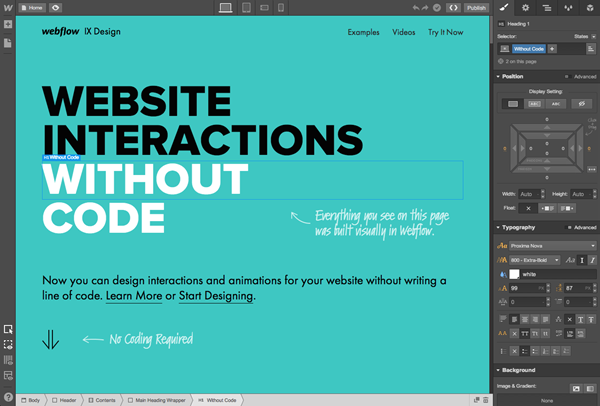Webflow Could Be the Future of Design and Development
Design and content, content and design, web designers from all around know the two don’t always play nice, and often the opinions differ on which should come first. But what if there were a way the two could not only work together more easily but, enjoy a somewhat symbiotic relationship of inspiration for one another, while also allowing designers to produce nice, clean, production ready code?
Webflow, has found a way to do just that. Below, I interviewed John Moore-Williams, Head of Content Strategy at Webflow, to hear all about their platform and how it is impacting the world of web design.
Oh, Creative Freedom
As I mentioned in the video, I always love to have the conversation of not only how design and content interact with each other, but also how the creatives in those realms can push the boundaries and not be shackled by the coding side of things. During our conversation, John emphasized the advantage they offer in terms of code quality and not being template based. In starting from a blank canvas there is the creative freedom to accommodate whatever unique vision a user has in mind, and if mistakes are made, they offer guidance to get users back on track.
Another advantageous aspect that stuck out to me, is how instead of a dashboard, users log into what looks like their website, and can edit right there, to see immediately how changes affect the site appearance. Think of all the time saved if you’re a single screen user and you don’t have to go from back-end to front-end, refresh and wait and change and so on, (sigh).

But, What About The Process?!
You’re a web design professional, you are in love with the process, it can sometimes feel tedious and repetitive consolidating every stakeholder’s vision, both internally and externally, into that one final product but, simply put, it’s what gets you up in the morning. Where in this tried and true process, does Webflow fit in?
I will admit I had this question, as a web design junkie myself, so I was happy to find that John himself addressed this very question in a blog post on the Webflow site (It’s like he knew!).
In it, he made some great points about how the process is dating itself, but, spoiler alert, he doesn’t start off by showing how Webflow fits into the process, rather he suggests a new one and in this “whole different ballgame”, the starting pitcher is content while the closer is design. John perfectly captions the thought process behind his idea here, “The benefit of this is that it allows design to be shaped by the content, instead of trying to shoehorn the content into the visual style after the fact. And since the vast majority of websites exist to present content that drives action, this approach places the emphasis where it should be: on the content and how best to present it.”
My POV
Analogies aside, there are so many elements to successful website design, but at the heart of it are the business goals, and for those to be met, action is required. Design and user experience may show your customers to your door, but content arguably it was tells them why they should walk through it. Either way, getting to a place where the two can work together is I think, where the most concise, relevant websites are going to come from and if the process of creating them can be made simpler and more efficient, even better.

Laura Myers
A digital business, marketing and social media enthusiast, Laura thrives on asking unique, insightful questions to ignite conversation. At an event or remotely, she enjoys any opportunity to connect with like-minded people in the industry.